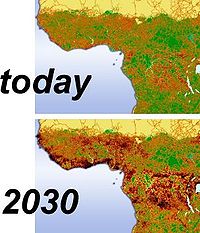
Photo from wikipedia
Abstract Habitat quality – referring to the structure of a habitat – is crucial for the habitat functions and biodiversity-related ecosystem services. Its effective assessment and monitoring is important to… Click to show full abstract
Abstract Habitat quality – referring to the structure of a habitat – is crucial for the habitat functions and biodiversity-related ecosystem services. Its effective assessment and monitoring is important to meet not only scientific interest, but also practical conservation regulations. We herein present the approach of using a composite indicator of riparian forest quality, both quantitatively (habitat quality index HQI [0|1]) and categorically (quality types QT 1…4 ), integrating a set of spatio-structural indicators derived from earth observation data. We apply the geon concept to aggregate multiple sets of statistically profound and conceptually meaningful indicators to the well-established patch concept. The main difference is that instead of using a priori units (e.g. existing patch delineations), new patches (geons) are derived that directly represent the phenomenon of habitat quality. Patch boundaries correspond to the gradients imposed by the multivariate behavior of the underlying indicators. The approach provides a truly spatially explicit assessment, while at the same time retaining the potential for decomposability on the level of individual indicators. The example of a riparian forest is chosen, as riparian zones are complex ecosystems with a high biodiversity that are highly threatened. In our case, riparian forest habitat quality was assessed using four indicators: (I) tree species composition, (II) horizontal forest structure, (III) vertical forest structure, and (IV) water regime. The distribution of habitat quality ( HQI) highlights hot- and cold-spots, where conservation measures may be needed. Cluster analysis reveals four types of patches that are characterized by a specific behavior of the aggregated indicators ( QT 1 = fair composition, QT 2 = (old growth) forest plantations, QT 3 = characteristic tree species, QT 4 = forest gaps). This categorization enables the prevailing or lacking aspects of quality to be determined based on the decomposability of the index. In addition, the resulting patches were evaluated using landscape metrics. The findings achieved on a statistically significant level show that patches with high HQI scores are better connected and form large patches with a characteristic tree species composition. In contrast, areas with low HQI values are characterized by a non-favorable tree species composition and the existence of clear-cut areas or access roads. A comparison with an assessment using a traditional composite indicator approach reveals the sensitivity of the different sets of indicators and assessment methods. The presented habitat quality index can be considered as suitable for the assessment and monitoring of riparian forest quality, supporting spatially explicit conservation measures and the evaluation of applied measures.
Journal Title: Ecological Indicators
Year Published: 2018
Link to full text (if available)
Share on Social Media: Sign Up to like & get
recommendations!